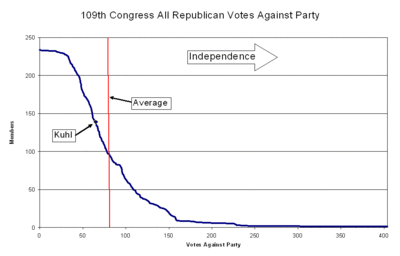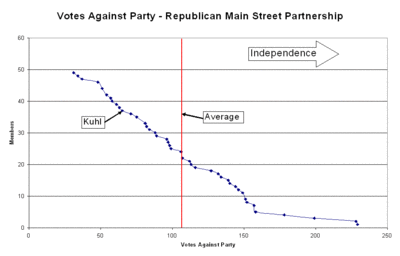Archive (2006)
More Bad Cheney PR
Wed, 09/20/2006 - 16:32 — RottenchesterThe Cheney visit was mentioned again in today's paper Democrat and Chronicle, and in the Messenger-Post. That latter story is awful for the Kuhl campaign, since it concentrates on a Kuhl vs.the Democrats catfight about whether the visit is a secret.
As usual, where there's bad PR for the Kuhl campaign, campaign manager and son James Kuhl isn't hard to find. James is a central figure in the M-P article. First, he denies that the visit was kept a secret, then he says:
he hadn't formally notified the media of the event "because we were instructed not to confirm the vice president's attendance."
Well, when the VP comes to town for your campaign and you don't issue a press release, you might not be keeping his visit a secret, but you're certainly downplaying it.
You're also leaving yourself open to letting your opponent frame the debate. Every story I've seen on the fundraiser has the cost of tickets and photo-ops front and center, because every story starts with the Massa campaign press release. If the Kuhl campaign had issued a release about Cheney's visit first, they'd be able to frame the fundraiser in a more positive light. Because Cheney is such a polarizing figure, that positive spin might not have stuck, but at least the first stories would not have been based solely on the words of Kuhl's opponent.
Measuring Kuhl's Independence
Wed, 09/20/2006 - 15:10 — RottenchesterLike all good political advertising, Randy Kuhl's new tag line -- "Accessible, Independent, Effective" -- sounds good and is hard to measure.
"Accessible" and "Effective" are subjective: Accessible to whom? Effective at what? I'll leave it to the reader to decide whether those components of Kuhl's slogan is true for them.
"Independent" is a little less tricky, because we can use the facts of Kuhl's voting record to measure it.
One common measurement of Kuhl's record is the claim that he votes with President Bush 93% of the time, which makes it sound like they're joined at the hip. But Congress votes a lot (the 109th has more than 1100 recorded votes), and most of those votes are for relatively minor, uncontested issues, like the naming of post offices or resolutions against cancer. Kuhl could argue, with some justification, that 93% isn't as close to Bush as it sounds.
Instead of an absolute percentage, let's compare Kuhl's votes to House Republicans in general. Kuhl's aso a member of the Republican Main Street Coalition, a centrist group that includes independents like John McCain in the Senate and fellow New Yorker Sherwood Boehlert in the House. Since Kuhl's predecessor Amo Houghton was a founding member of the coalition, it's worth seeing if Kuhl is keeping up the tradition of independence that this group represents.
The following graphs measure Kuhl's performance within these two peer groups. The horizontal (X) axis is the number of times a member has voted against the majority of his or her party. The vertical axis is the cumulative number of members who have a given number of "contrary" votes. Kuhl's position is clearly marked.
Another way of looking at these graphs is that the "pack" is on the left and the "rebels" are on the right. The farther right a member is plotted on the graph, the more independent (against the pack) they are.
This first graph shows where Kuhl stands in relation to the rest of Republicans. The red line represents the average number of times that a Republican votes against his or her party: 83 times. Randy Kuhl's 65 votes against the majority is well under that number. By that measure, he's less independent than average.
The second graph plots Kuhl's standing among the 49 members of the Republican Main Street Coalition. Kuhl's 65 contrary votes is far below the group average of 106. Kuhl's standing here is well within the bottom third of Main Street members.
The conclusion I draw from these numbers is that Kuhl's claim of independence is suspect at best. He votes with his party more than average, and far more than the average of a self-identified group of independents. In fact, in the New York Republican delegation, Kuhl is second only to Tom Reynolds in party loyalty.
-------------
Notes on the data: This report used the dataset of votes created by UCLA professors Jeff Lewis and Keith Poole, and limits votes to those taken prior to September, 2006. Any errors here are mine, not theirs.
VFW Endorses Massa
Tue, 09/19/2006 - 18:15 — RottenchesterThe Veterans of Foreign Wars (VFW) Political Action Committee has endorsed Eric Massa. This is interesting for a few reasons. First, in 2004, the PAC made no endorsement in the 29th race. Second, the VFW-PAC has a history of party-neutral support. Finally, the VFW endorsement again rubs the district sore spot of the Canandaigua VA Hospital. So, unlike Eliott Spitzer's endorsement of Massa, which also occurred today and was nothing if not expected, the VFW endorsement is actually news.
Debates
Mon, 09/18/2006 - 15:58 — RottenchesterThe Kuhl campaign has announced four debates, of which three have apparently been agreed to by the Massa Campaign:
- "Debate 1" is in Canandaigua on October 5, sponsored by the Messenger-Post newspaper and the Canandaigua Rotary Club.
- "Debate 2" is in Elmira on October 10, sponsored by WETM (a NBC affiliate in Elmira) and the Corning Leader.
- The third debate is in Bath on October 11, and is sponsored by the League of Women Voters.
- The fourth debate, which according to Kuhl hasn't been confirmed by the Massa Campaign, is on the WLEA radio station in Hornell.
- (Update) The fifth debate is October 16 at 7:00 p.m. on RNews, the Rochester Time-Warner Cable news channel.
On the Ground
Mon, 09/18/2006 - 08:42 — RottenchesterYesterday the town of Pittsford had a community celebration. Pittsford is an affluent, mainly Republican suburb in the North end of the 29th. The town supervisor, county legislator, state senator and assemblyman are all Republicans.
I was there for a couple of hours and saw Eric Massa and over a dozen residents wearing Massa t-shirts, as well as Massa flyers on every table. There was no Kuhl presence - no flyers, no signs, nothing. With less than two months remaining in the campaign, I found that surprising.
Will the Unions GOTV?
Mon, 09/18/2006 - 07:41 — RottenchesterToday's Binghamton paper covers the role of unions in New York's close congressional elections. The national AFL-CIO has a $40 million warchest, and they plan to spend some of it on races in New York's 20th and 24th districts. The 29th would get union attention only if the race appears to be close.
Kuhl's New Ad
Sun, 09/17/2006 - 13:06 — RottenchesterRandy Kuhl's new ad is a positive, first-person accounting of federal money spend in the district. It also introduces a new campaign tag line: "Accessible, Independent, Effective: Congressman Randy Kuhl". Here it is:
Kuhl, Massa "Debate" in the New York Times
Sat, 09/16/2006 - 18:59 — RottenchesterA New York Times article on the Democrats and the Iraq war quotes Eric Massa and Randy Kuhl extensively.
I've detailed Massa's position earlier, and the Times article added nothing new. What's new to me is Kuhl's response:
“That’s the old cut and run,” Mr. Kuhl said. “I will not send up the white flag as my opponent says he will.”
An Immediate Investigation
Sat, 09/16/2006 - 11:25 — Rottenchester
Randy Kuhl wants Eliot Spitzer to launch an immediate investigation into gas price gouging in the 29th:
"I
was shocked to drive from New York to Washington and watch the price of
gas drop from a high of over $2.80 in the 29th District down to near
$2.30 in Pennsylvania,” said Rep. Kuhl. “If the difference in state
taxes between New York and Pennsylvania is only eleven cents, then
obviously there is something going on in New York if there’s a fifty
cent difference in price for the same product. We have price gouging
statutes on the books in New York and they ought to be used by the
Attorney General to stop this practice from occurring."
I think Elliot Spitzer is a little busy right now. But I've got some free time. Here are the results of my immediate investigation.
The Department of Energy tracks the average retail price of gasoline in major US markets, and they have the data formatted for download. Data for New York is tracked, as is data for regions. New York is in the central-Atlantic region, which also includes Delaware, DC, Maryland, New Jersey and Pennsylvania: in other words, all of Kuhl's drive home is in this region.
I'm no energy expert, but here's what my investigation of the data has found: Over a five-year period, New York State gas prices have been roughly 9 cents higher than the regional average (see the graph). In October, 2005, the price difference reached a five-year maximum of 18.2 cents. The last data point, taken on 9/11, shows that we're at a 13.6 cent difference, which is above the mean but below the historical maximum.
"Gouging" is a political term which generally means that suppliers are taking advantage of a short-term shortage to extract a maximum profit. It looks like, on average, New York gas prices have been higher than the region for years.
I'll grant Randy that this data is an average across New York, and doesn't single out the 29th. But we've all had the experience of driving across state lines and seeing lower gas prices. There's nothing shockingly new here, and Randy's call for an investigation is a classic red herring. High gas prices are a nationwide, market-based phenomenon. There's no cabal of greedy gas station owners ripping off voters in the 29th, and Kuhl knows it.
Evidence of Democratic GOTV
Fri, 09/15/2006 - 14:12 — RottenchesterThe state Democratic party has opened a temporary office in Penn Yan. Normally, offices in little burgs like Penn Yan are only opened during presidential election years. According to the story,
organizers felt it was important this year, particularly with high-profile Democratic candidates, such as Massa, Sen. Hillary Rodham Clinton's re-election bid and Eliot Spitzer's run for governor.
This is concrete evidence that the Democrats are serious about GOTV in the 29th this Fall.
Two Votes on Half-Measures
Fri, 09/15/2006 - 08:49 — RottenchesterRandy Kuhl's latest major votes have been, predictably, with the Republican majority. They both reflect that majority's failure to come to terms with two big issues:
- The Secure Fence Act of 2006 is just one component -- and probably the least effective one -- of a new immigration policy that's stalled in Congress.
- The Earmarking "reform" bill is the result of gutting lobbying reform. It establishes a public database of earmarks while avoiding the larger issues raised by the Abramoff scandal.
Both of these bills were passed strictly to give legislators something to take back to their campaigns this Fall. Calling them "half-measures" is generous -- "band-aid" or "g-string" would probably be more accurate. Voters in the 29th should still feel free to wonder why Congress can't police itself or deal with immigration.
Yard Signs
Thu, 09/14/2006 - 10:51 — RottenchesterOn my daily commute in the far North of the 29th, I've noticed a new Massa lawn sign every day for the past 3 days. These signs are placed in front lawns, not at exit ramps or busy corners. That's a small but interesting indication of voter interest and campaign organization. I've yet to see a Kuhl sign.


